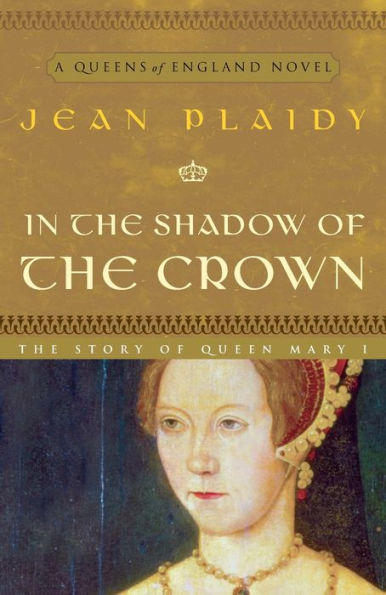In the Shadow of the Crown: A Novel
As Henry VIII's only child, the future seemed golden for Princess Mary. She was the daughter of Henry's first queen, Katharine of Aragon, and was heir presumptive to the throne of England. Red-haired like her father, she was also intelligent and deeply religious like her staunchly Catholic mother. But her father's ill-fated love for Anne Boleyn would shatter Mary's life forever. The father who had once adored her was now intent on having a male heir at all costs. He divorced her mother and, at the age of twelve, Mary was banished from her father’s presence, stripped of her royal title, and replaced by his other children—first Elizabeth, then Edward. Worst of all, she never saw her beloved mother again; Katharine was exiled too, and died soon after. Lonely and miserable, Mary turned for comfort to the religion that had sustained her mother.
In a stroke of fate, however, Henry's much-longed-for son died in his teens, leaving Mary the legitimate heir to the throne. It was, she felt, a sign from God—proof that England should return to the Catholic Church. Swayed by fanatical advisors and her own religious fervor, Mary made horrific examples of those who failed to embrace the Church, earning her the immortal nickname "Bloody Mary." She was married only once, to her Spanish cousin Philip II—a loveless and childless marriage that brought her to the edge of madness.
With In the Shadow of the Crown, Jean Plaidy brings to life the dark story of a queen whose road to the throne was paved with sorrow.
"1103375924"
In a stroke of fate, however, Henry's much-longed-for son died in his teens, leaving Mary the legitimate heir to the throne. It was, she felt, a sign from God—proof that England should return to the Catholic Church. Swayed by fanatical advisors and her own religious fervor, Mary made horrific examples of those who failed to embrace the Church, earning her the immortal nickname "Bloody Mary." She was married only once, to her Spanish cousin Philip II—a loveless and childless marriage that brought her to the edge of madness.
With In the Shadow of the Crown, Jean Plaidy brings to life the dark story of a queen whose road to the throne was paved with sorrow.
In the Shadow of the Crown: A Novel
As Henry VIII's only child, the future seemed golden for Princess Mary. She was the daughter of Henry's first queen, Katharine of Aragon, and was heir presumptive to the throne of England. Red-haired like her father, she was also intelligent and deeply religious like her staunchly Catholic mother. But her father's ill-fated love for Anne Boleyn would shatter Mary's life forever. The father who had once adored her was now intent on having a male heir at all costs. He divorced her mother and, at the age of twelve, Mary was banished from her father’s presence, stripped of her royal title, and replaced by his other children—first Elizabeth, then Edward. Worst of all, she never saw her beloved mother again; Katharine was exiled too, and died soon after. Lonely and miserable, Mary turned for comfort to the religion that had sustained her mother.
In a stroke of fate, however, Henry's much-longed-for son died in his teens, leaving Mary the legitimate heir to the throne. It was, she felt, a sign from God—proof that England should return to the Catholic Church. Swayed by fanatical advisors and her own religious fervor, Mary made horrific examples of those who failed to embrace the Church, earning her the immortal nickname "Bloody Mary." She was married only once, to her Spanish cousin Philip II—a loveless and childless marriage that brought her to the edge of madness.
With In the Shadow of the Crown, Jean Plaidy brings to life the dark story of a queen whose road to the throne was paved with sorrow.
In a stroke of fate, however, Henry's much-longed-for son died in his teens, leaving Mary the legitimate heir to the throne. It was, she felt, a sign from God—proof that England should return to the Catholic Church. Swayed by fanatical advisors and her own religious fervor, Mary made horrific examples of those who failed to embrace the Church, earning her the immortal nickname "Bloody Mary." She was married only once, to her Spanish cousin Philip II—a loveless and childless marriage that brought her to the edge of madness.
With In the Shadow of the Crown, Jean Plaidy brings to life the dark story of a queen whose road to the throne was paved with sorrow.
19.0
In Stock
5
1

In the Shadow of the Crown: A Novel
416
In the Shadow of the Crown: A Novel
416Paperback(First Three Rivers Press Paperback Editi)
$19.00
19.0
In Stock

Product Details
| ISBN-13: | 9780609810194 |
|---|---|
| Publisher: | Crown Publishing Group |
| Publication date: | 05/18/2004 |
| Series: | A Queens of England Novel , #6 |
| Edition description: | First Three Rivers Press Paperback Editi |
| Pages: | 416 |
| Sales rank: | 1,085,214 |
| Product dimensions: | 5.25(w) x 7.97(h) x 0.89(d) |
About the Author
From the B&N Reads Blog
